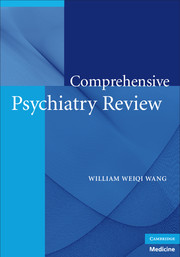Book contents
- Frontmatter
- Contents
- Introduction
- PART I INTELLECTUAL FOUNDATION OF PSYCHIATRY
- PART II EVALUATION AND MEASUREMENT
- 6 Evaluation of Signs and Symptoms
- 7 Classification and Diagnosis
- 8 Psychometrics
- 9 Biostatistics
- PART III PSYCHIATRIC DISORDERS
- PART IV PSYCHIATRIC THERAPEUTICS
- PART V NEUROPSYCHIATRY AND RELEVANT NEUROLOGIC CONDITIONS
- PART VI SPECIAL TOPICS
- PART VII REVIEW QUESTIONS
- Bibliography
- Index
7 - Classification and Diagnosis
from PART II - EVALUATION AND MEASUREMENT
Published online by Cambridge University Press: 18 January 2010
- Frontmatter
- Contents
- Introduction
- PART I INTELLECTUAL FOUNDATION OF PSYCHIATRY
- PART II EVALUATION AND MEASUREMENT
- 6 Evaluation of Signs and Symptoms
- 7 Classification and Diagnosis
- 8 Psychometrics
- 9 Biostatistics
- PART III PSYCHIATRIC DISORDERS
- PART IV PSYCHIATRIC THERAPEUTICS
- PART V NEUROPSYCHIATRY AND RELEVANT NEUROLOGIC CONDITIONS
- PART VI SPECIAL TOPICS
- PART VII REVIEW QUESTIONS
- Bibliography
- Index
Summary
The idea of how to formulate a working definition for mental illness has evolved since the asylum era. The goal of establishing diagnostic criteria is not to provide final words in illness and healing, but to distinguish clinical conditions with the available information and knowledge, to facilitate treatment and communication among health-care professionals. In the early stage of developing a system of diagnostic criteria, there were polarized debates concerning the rational concepts of psychiatric illness. Psychoanalysts, along with members of other psychological schools, challenged the biomedical model in that the latter's reductionistic approach omitted the humane nature of mental disorders. However, the lack of testable evidence to support the asserted etiology also made psychoanalytical claims dubious. In 1977, George L. Engel (1913–1999), a New York psychiatrist, proposed biopsychosocial model. This holistic, tri-dimensional model set the foundation of psychiatric work in the late part of the twenty-first century, and is still widely applied in fields within and beyond psychiatry. At the same time, scientific research started to put all the theoretical models, including psychoanalytic ones, under the test of evidence. In the past decade, evidence-based medicine met with plaudits from the professional circle and general public. It is now clear that evidence-based medicine will set the precept for future versions of diagnostic system in psychiatry and the rest of the medical world.
The two most important psychiatric classifications are Diagnostic and Statistical Manual of Mental Disorders (DSM) developed by the American Psychiatric Association (APA), and International Classification of Diseases (ICD), developed by the World Health Organization (WHO).
- Type
- Chapter
- Information
- Comprehensive Psychiatry Review , pp. 54 - 56Publisher: Cambridge University PressPrint publication year: 2009



